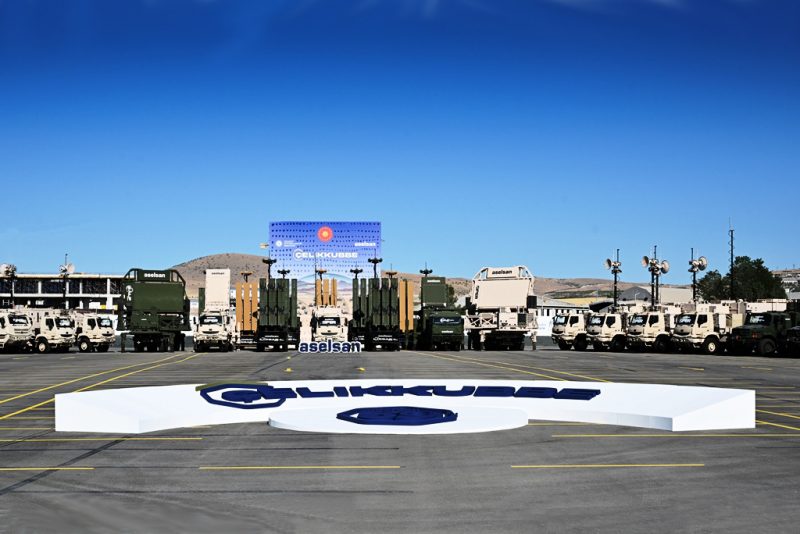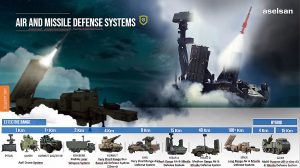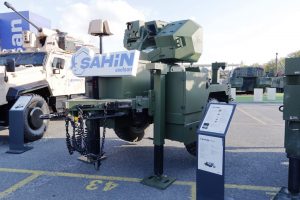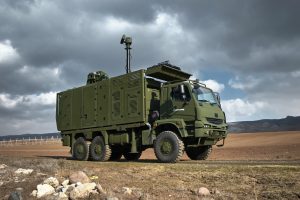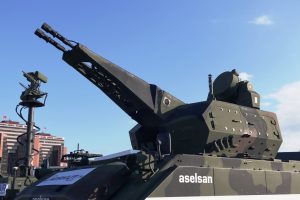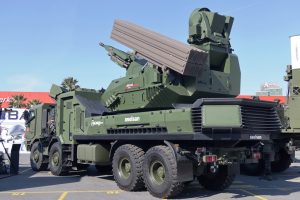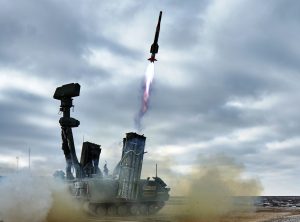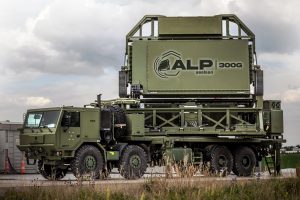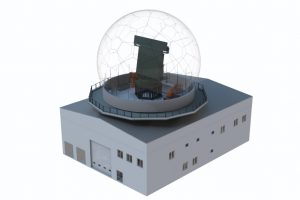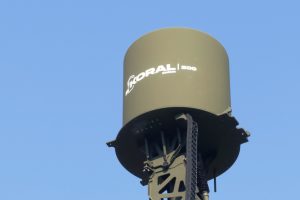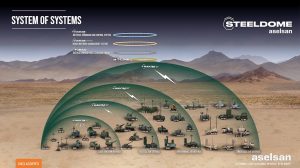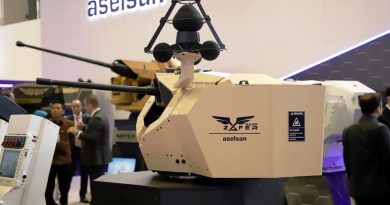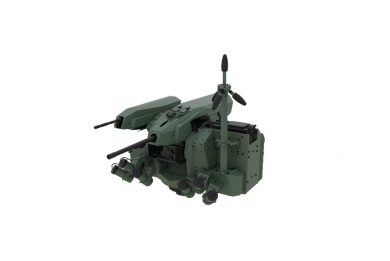Aselsan, a multi-layer multi-domain Steel Dome to protect Turkey from air threats
The recent visit to Aselsan allowed to detail the Steel Dome project, a spiralling programme aiming at ensuring the defence of the Turkish territory from threats coming from the third dimension. This overarching system is made of communications networks linking several sensors and effectors, acting under an artificial intelligence-based command and control system, providing a multi-layer multi-domain system capable to neutralise threats from micro-drones to long-range missiles
With threats ranging from FPV drones to ballistic missiles, defending a country territory needs inevitably a layered solution, allowing not only to neutralise every type of projectile aimed at a valuable target, budget considerations in terms of money and available effectors advising against intervening against projectiles intended not to cause damage, but to neutralise it with the most cost-effective solution, the Steel Dome, Celik Kubbe in Turkish language.
Recent conflicts have shown how much air defence has to do with budgeting, hence the reason for generating “smart layers”, as Aselsan experts defined them, these being either soft- or hard-kill, with different ranges, to ensure the right answer for each threat.
Starting from effectors, those with the shorter operational range are dedicated to the C-UAS mission. The İhtar 100 includes a Ku-band radar used for drone detection, an electro-optic day/night suite with 3rd generation thermal imager for identification, and an active jamming countermeasure operating in the 2G, 3G, 4.5G/LTE, Wi-Fi, GNSS, remote control, and data/image links bands ensuring threat neutralisation. Another soft-kill system part of the Steel Dome is the Kangal, a software defined programmable jamming system with 360° spherical coverage capable to jam mini/micro/FPV control frequencies, video transmitting as well as GNSS frequencies. Both those systems are ineffective against fibre-optic guided FPV drones, hence the need of hard-kill effectors. The Şahin is a stabilised turret fitted with a multi-spectral sensor suite including day/night cameras and laser rangefinder, and armed with a Mk19 automatic grenade launcher, with a ready-to-fire load of 64 40 mm grenades. These are part of the Atom family developed by Aselsan; the Atom 40 mm High Velicity Air Burst Munition used in the Şahin generates over 500 fragments and is programmed to detonate in the vicinity of the target thanks to the adoption of a time fuse. The warhead has a kill radius of 5 metres and a maximum effective range of 700 metres against drones.
Should the need arise to kill the drone at a longer range, Aselsan provides the Gökberk mobile laser weapon system, a short-range containerised air defence solution mounted on a 6×6 truck. It is based on a 5-kW single-mode laser source developed by Tübitak Bilgem, delivering high beam quality for hard-kill engagements. During the visit to the Aselsan facility EDR On-Line understood that the company is working on more powerful 10-kW, 15-kW, 30-kW and even more powerful solutions, which will offer longer neutralisation ranges. An integrated electronic jammer by Aselsan enables soft-kill effects within the same system, allowing flexible responses depending on the threat profile. Fitted with an electro-optic suite, it has an effective range against drones of 1 to 1.5 km.
With a similar range we then find the Korkut 25, a stabilised turret armed with a 25×137 mm automatic cannon firing the Atom 25 ABM round, which works on a similar principle of the aforementioned Atom 40, but in this case it has a pre-fragmented steel body that generates an undisclosed number of shrapnels.
A considerable step forward in range comes when switching to the 35×228 mm calibre, the over 1,000 m/s muzzle velocity ensuring an operational range of around 4,000 metres; while effective against drones, here we enter the true air defence field, helicopters, and other air breathing systems, and not only, becoming targets of choice. The Atom 35 ABM round contains 160 tungsten cylinders, the time-programmable base fuse “opening” the shell at an optimised distance in front of the incoming threat, generating a deadly could of metal. This round is effective against fixed and rotary wing aircraft, missiles and UAVs. The Atom 35 IABM, where “I” stands for “Intense” carries a load of 400 smaller 400 cylinders and is optimised against slow moving targets and UAVs, with a 2 km range, or against infantry targets, with a 5 km range. Both those rounds are available. EDR On-Line understood Aselsan is working on a dedicated C-RAM round, capable to neutralise rocket-artillery-mortar rounds, another threat to be added to flying objects; the new round is still under development and will maintain the same characteristics of the current Atom 35 munitions, but its payload will be specifically adapted to the new role, possibly carrying 800 smaller pellets.
Different systems are in service with the Turkish military in the 35 mm calibre, all belonging to the Korkut family, and all capable to use the programmable Atom 35 ABM rounds. Starting from the static solution, the Korkut 110/35, now known as Göker, is a turret designed to be deployed in fixed facilities and border areas, armed with a single-barrel cannon with a -35°/+95° elevation arc, rate of fire being set between 60 and 550 rounds per minute. The redeployable Korkut 130/35 is based on twin 35 mm towed gun mounts linked to a fire control centre. Finally comes the Korkut 150/35, the fully mobile 35 mm solution, a twin-barrel 35 mm stabilised turret with tracking radar, mounted on a tracked chassis provided by FNSS ensuring a speed on road of over 65 km/h; the turret hosts 200 ready-to-fire rounds, the automatic linkless ammunition feed mechanism allowing to switch between two types of rounds.
A hybrid solution represents the bridge between guns and missiles; the Gürz 150 is a truck-mounted system based on an 8×8 chassis, armed with a single-barrel Atom-capable 35 mm cannon and two launchers, each hosting four missiles. The launcher on the left side hosts short-range surface-to-air missiles, possibly a surface-to-air version of the air-to-air Bozdoğan missile developed by Tübitak Sage. On the prototype seen in the last exhibitions very short-range missiles were clustered around the main gun, two per side, while on brochures and other company materiel these seem to have been relocated in a specific four-cell launcher on the right side of the turret; EDR On-Line understood that VSHORAD effectors can be either US-made Stinger or locally made Sungur missiles. These can also be found on the PMADS (Pedestal Mounted Air Defence System), installed on a 4×4 light vehicle. Beside the three hard-kill effectors, the Gürz 150 is also fitted with a jammer, which can be used to defeat incoming drones, sparing 35 mm rounds and missiles for more critical targets. The flat antennas of a Kalkan 050-G multifunction AESA radar could be seen at the four corners of the system, once again brochures showing a different setup. On top rear of the turret the fire direction radar and optronics was visible. Thanks to its flexible suite of effectors, the Gürz150 covers ranges from 4 to 15 km.
Switching to all-missile systems, the Hisar A is also a 15 km range GBAD system, based on a tracked platform carrying a two-cell launcher per side hosting IIR guided missiles, surveillance being provided by a Kalkan 200-G radar installed on top of a mast. The next step is the Hisar O, interception range increasing to 25 km; truck-based, each launch platform carries six IIR or RF guided missiles, which gives considerable flexibility allowing optimising the effector according to the incoming threat. One battery is composed of at least three launchers, one fire control centre a medium altitude radar and an electro-optical system, the two installed on different vehicles.
Finally comes the Siper, which battery layout does not differ much from that of the Hisar O; here missiles have a wholly different range, that of the Siper Block 1 being over 70 km, with an interception altitude of 20,000 metres, the Block 2 increasing those figures to over 150 km and 30,000 metres. Here the surveillance radar is the Alp 300-G operating in the S-band, capable to detect and track air breathing targets, anti-radiation missiles and stealth/low RCS targets from very long ranges. The radar can be employed in two modes, rotating or staring, coverage being therefore 360° or possibly 120°, the latter option providing the greater detection range which EDR On-Line understood being around 650 km. The Siper Block 3 is currently in development; this will have a range in excess of 180 km, will be able to deal with ballistic missiles and, according to what EDR On-Line understood during the visit, it will also be capable to cope with hypersonic threats. According to Aselsan sources the Siper Block 3 will be available in two-year time.
For detecting incoming threats, the Steel Dome will deploy several sensors, not only those integral to GBAD systems; beside additional land-based sensors, such as fixed radar sites equipped with the longer range S-band Alp 500-G and in the future the Alp 600-G, satellites and airborne sensors will contribute to generate the recognised air picture. Turkey being surrounded by sea on three sides also naval assets can provide their inputs; for example, should the radars of the TF-2000 air defence frigates detect any incoming threat they cannot deal with directly, they will pass them over to the Steel Dome control centre, acting as early warning sensors. EDR On-Line understood that the Steel Dome control centre was developed as a distributed system, to avoid being neutralised by a single enemy shot.
Aselsan’s Turan is the artificial intelligence-powered tactical unified radio access network that ensures the interconnection between all Steel Dome elements. The company Hakim 100/RAD is the system that ensures the radar network management, the Hakim ADOC (Air Defence Operations Centre) being the air space command and control system. The Hakim ADOC is the heart of the Steel Dome; it is here that high-level AI algorithms elaborate the optimal solutions that are proposed to commanders, reducing the operators’ workload, and dramatically shortening the reaction time. They take into consideration data coming from all sources, satellites, AWACS, fighters, UAVs, ground radars, EW systems and from constantly updated data-base on threats; the Threat Evaluation and Weapon assignment Algorithms, TEWA in short, generates the solutions that reach the various levels of command, proposing for example to a Gürz self-propelled GBAD/C-UAS system which effector to use, based not only on tactical but also on budget considerations, as previously discussed.
The Steel Dome is currently composed of 47 types of products; beside those already mentioned we find, for example, electronic warfare assets such as radar electronic support/attack systems part of the Koral family, or the Puhu 3-LT V/UHF communication electronic support/attack system. All Aselsan divisions are involved in the Steel Dome; beside the five divisions dealing with defence products, also the sixth one is concerned by the system, Turkey aiming at creating a warning system for the population. This is done through the BiGA APCO (Association of Public Safety Communications Officials), which acts as a bridge between the military network and the civilian public alert system, ensuring that alarms reach the population in a timely manner.
All the Steel Dome was designed according to NATO standards, and therefore it is fully interoperable with other systems in use by Allied nations. On May 27th, 2025, the NATO Support and Procurement Agency (NSPA) awarded modular ground-based air defence (GBAD) system architecture contracts to five companies, Aselsan being part of them, the other being Airbus, Lockheed Martin UK, Raytheon, and Thales. The concept stage value is worth Euro 20 million. One or two of the companies participating in the first phase of the programme will be selected for phase two and will develop the future NATO GBAD architecture.
As for the Steel Dome, in early September Aselsan delivered several subsystems to the Turkish Secretariat of Defence Industries (SSB). Considering the surface of Turkey, over 780,000 km2, it will be very difficult to cover the entire territory, something that smaller countries such as Israel, which surface is less than 3% that of Turkey, managed to do. Considering their range, sensors will quite probably be able to cover the whole country, which will not be the case for effectors, these providing “bubbles” of different type depending on targets, four air defence levels being considered, strategic, operational, tactical, and close area. Aselsan is currently conducting some coverage analysis in cooperation with the Air Force and with the SSB, the service concept of operations being a key factor in this phase; EDR On-Line understood that a prioritisation study is ongoing, however it must also be underlined that most of the systems are highly mobile, hence a quick redeployment can be performed should the situation change. Modularity also allows the system to grow with time, not mentioning the addition of new state-of-the-art sensors and effectors.
The Steel Dome is not something that will maintain the same configuration over the years; with technology advancing, and new systems being developed, these will be added thanks o to its open architecture, while AI-based algorithms will also evolve, machine learning certainly being a key player, making the multi-layer multi-domain air defence system protecting Turkey a living system.
Graphics courtesy Aselsan, photos courtesy Aselsan and P. Valpolini

